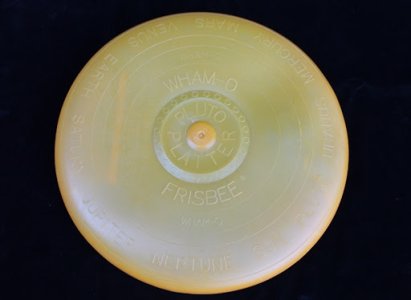January 23, 1957
Wham-O began mass-producing its first flying discs under the “Pluto Platter” moniker, kicking off what would soon become one of the most popular toys in company history.
The Frisbee story starts in college," writes the National Museum of Play, which inducted the plastic surf-and-sand flying disc into its Toy Hall of Fame in 1988.
"Late 19th-century students at Yale and other New England universities played catch with pie plates … made by the nearby Frisbie Baking Company of Bridgeport, Connecticut . They yelled ‘Frisbie!’ to warn passersby away from the spinning discs."
The activity spread to campuses and beaches around the country.
California entrepreneur Walter Frederick Morrison was struck by the idea of marketing flying discs in 1937 when, according to industry lore, somebody at a beach in Santa Barbara offered him 25 cents for a pie plate that he was flinging around with his wife-to-be Lucille.
An idea arose, but WWII interrupted his plans.
Morrison tried to sell his invention under the names “Flying Saucer” and “Pluto Platter” with disappointing results. Daunted, Morrison sold the rights to his product to notable toy company Wham-O in 1957.
Not long after production started, a pair of Wham-O employees recalled a recent trip to Connecticut where they witnessed youngsters throwing around disc-shaped pie plates and yelling “Frisbie!” whenever one of them flew off course. When the company decided to rework its flying disc design — adding more ridges to make the toy more aerodynamic and stable — they also renamed it the Frisbee, purposefully altering the spelling to ward off potential lawsuits from the Bridgeport bakery. The newly redesigned and rebranded Frisbee flew off store shelves nationwide. It quickly became one of the most iconic American toys of the 20th century.
It is estimated that over 90% of all Americans have tossed a frisbee at least once.
View attachment 716701
View attachment 716704





